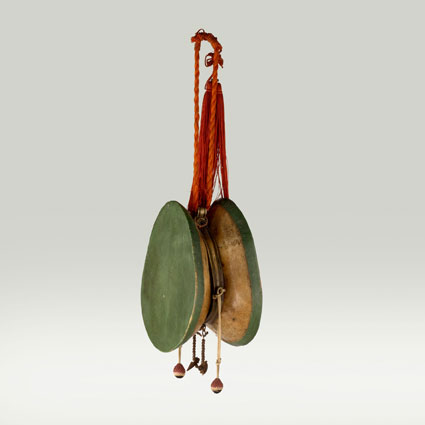Damaru – ritual two-headed drum
ABR 032
Code: ABR 032
Country: Tibet
Style:
Date: 1800 - 1900
Dimensions in cm WxHxD: 13 x 16 x 8
Materials: Bone
Damaru
(From Wikipedia the free encyclopedia)
A damaru is a small two-headed drum shaped like an hourglass. The drum is typically made of wood, with leather drum head, or made out of human skulls. Its height ranges from a few inches to a little over a foot. It is played one handed. The strikers are typically beads fastened to the ends of leathern cords around the waist of the damaru. Knots in the leather can also be used as strikers. As the player waves the drum using a twisting wrist motion, the strikers beat on the drumhead.
The damaru is well known throughout the Indian subcontinent. The Damaru is known as a power drum, and when played tends to bring spiritual energy. It is especially associated with the Hindu deity Shiva. One legend has it that Shiva gave the world its first syllabary as the sounds of the Sanskrit language arose from his drumbeats (see Shiva Sutra for the sounds). The damaru is used by itinerant musicians of all stripes, due to its small portable size. It is also used in Tibetan Buddhism in a ritual manner particularly with the trance sadhana of the Chöd.
The hourglass-shaped drum known in Sanskrit as "damaru" is a sacred instrument used in ritual shamanic performances in Mongolia, India and Tibet.
Its curved shape is a symbolic unification of yin and yang. Fashioned out of a human cranium, the drum is comprised of two skulls: a boy of sixteen and a girl of twelve. Monkey skins are stretched tightly over the skulls. One side is smeared with sperm, and the other side is decorated with a lotus blossom coated with a twelve-year-old girl's menstrual blood. The hide is then pierced with sixteen holes and attached to the drum with human hair. The whirling balls are made of the bones of a waterbird's foot and wrapped in wax and cloth.
The damaru drum is an ancient and spiritually potent symbolic medium for ritual music and magic used to communicate the intangible abstract other world through the senses.
In India, the damaru is so highly regarded as a spiritual instrument that everything to do with it is ritualized. It must even be correctly placed with the male skull to the musician's right and the female to his left in accordance with the traditional Yin Yang (masculine/feminine) order.
(From Wikipedia the free encyclopedia)
A damaru is a small two-headed drum shaped like an hourglass. The drum is typically made of wood, with leather drum head, or made out of human skulls. Its height ranges from a few inches to a little over a foot. It is played one handed. The strikers are typically beads fastened to the ends of leathern cords around the waist of the damaru. Knots in the leather can also be used as strikers. As the player waves the drum using a twisting wrist motion, the strikers beat on the drumhead.
The damaru is well known throughout the Indian subcontinent. The Damaru is known as a power drum, and when played tends to bring spiritual energy. It is especially associated with the Hindu deity Shiva. One legend has it that Shiva gave the world its first syllabary as the sounds of the Sanskrit language arose from his drumbeats (see Shiva Sutra for the sounds). The damaru is used by itinerant musicians of all stripes, due to its small portable size. It is also used in Tibetan Buddhism in a ritual manner particularly with the trance sadhana of the Chöd.
The hourglass-shaped drum known in Sanskrit as "damaru" is a sacred instrument used in ritual shamanic performances in Mongolia, India and Tibet.
Its curved shape is a symbolic unification of yin and yang. Fashioned out of a human cranium, the drum is comprised of two skulls: a boy of sixteen and a girl of twelve. Monkey skins are stretched tightly over the skulls. One side is smeared with sperm, and the other side is decorated with a lotus blossom coated with a twelve-year-old girl's menstrual blood. The hide is then pierced with sixteen holes and attached to the drum with human hair. The whirling balls are made of the bones of a waterbird's foot and wrapped in wax and cloth.
The damaru drum is an ancient and spiritually potent symbolic medium for ritual music and magic used to communicate the intangible abstract other world through the senses.
In India, the damaru is so highly regarded as a spiritual instrument that everything to do with it is ritualized. It must even be correctly placed with the male skull to the musician's right and the female to his left in accordance with the traditional Yin Yang (masculine/feminine) order.
Beer, Robert , 2003. Les symboles du bouddhisme Tibétain. Albin Michel. Pp. 172-177
Bock, Etienne; Falcombello, Jean-Marc; Jenny Magali, 2022. Trésors du Tibet. Sur les pas de Milarépa.. Paris: Flammarion. P. 170
Bock, Etienne; Falcombello, Jean-Marc; Jenny Magali, 2022. Trésors du Tibet. Sur les pas de Milarépa.. Paris: Flammarion. P. 170

